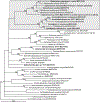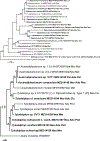Molecular phylogeny of Diplostomum, Tylodelphys, Austrodiplostomum and Paralaria (Digenea: Diplostomidae) necessitates systematic changes and reveals a history of evolutionary host switching events
- PMID: 34371018
- PMCID: PMC8742756
- DOI: 10.1016/j.ijpara.2021.06.002
Molecular phylogeny of Diplostomum, Tylodelphys, Austrodiplostomum and Paralaria (Digenea: Diplostomidae) necessitates systematic changes and reveals a history of evolutionary host switching events
Abstract
The Diplostomidae Poirier, 1886 is a large, globally distributed family of digeneans parasitic in intestines of their definitive hosts. Diplostomum and Tylodelphys spp. are broadly distributed, commonly reported, and the most often sequenced diplostomid genera. The majority of published DNA sequences from these genera originated from larval stages only, which typically cannot be identified to the species level based on morphology alone. We generated partial large ribosomal subunit (28S) rRNA and cytochrome c oxidase subunit 1 (cox1) mtDNA gene sequences from 14 species/species-level lineages of Diplostomum, six species/species-level lineages of Tylodelphys, two species/species-level lineages of Austrodiplostomum, one species previously assigned to Paralaria, two species/species-level lineages of Dolichorchis and one unknown diplostomid. Our DNA sequences of 11 species/species-level lineages of Diplostomum (all identified to species), four species/species-level lineages of Tylodelphys (all identified to species), Austrodiplostomum compactum, Paralaria alarioides and Dolichorchis lacombeensis originated from adult specimens. 28S sequences were used for phylogenetic inference to demonstrate the position of Paralaria alarioides and Dolichorchis spp. within the Diplostomoidea and study the interrelationships of Diplostomum, Tylodelphys and Austrodiplostomum. Our results demonstrate that two diplostomids from the North American river otter (P. alarioides and a likely undescribed taxon) belong within Diplostomum. Further, our results demonstrate the non-monophyly of Tylodelphys due to the position of Austrodiplostomum spp., based on our phylogenetic analyses and morphology. Furthermore, the results of phylogenetic analysis of 28S confirmed the status of Dolichorchis as a separate genus. The phylogenies suggest multiple definitive host-switching events (birds to otters and among major avian groups) and a New World origin of Diplostomum and Tylodelphys spp. Our DNA sequences from adult digeneans revealed identities of 10 previously published lineages of Diplostomum and Tylodelphys, which were previously identified to genus only. The novel DNA data from this work provide opportunities for future comparisons of larval diplostomines collected in ecological studies.
Keywords: 28S; Cox1; Diplostomidae; Diplostomum; Molecular phylogeny; Tylodelphys.
Copyright © 2021 Australian Society for Parasitology. Published by Elsevier Ltd. All rights reserved.
Figures




Similar articles
-
Molecular data reveal diversity of Tylodelphys spp. (Trematoda: Diplostomidae) in India: with evidence of new lineages, morphology and statistical analysis.Mol Biol Rep. 2025 Mar 26;52(1):336. doi: 10.1007/s11033-025-10456-9. Mol Biol Rep. 2025. PMID: 40138082
-
Metacercariae in the brain of Erythrinus cf. erythrinus (Characiformes: Erythrinidae) from Iguazú National Park (Argentina): do they belong to Dolichorchis lacombeensis (Digenea, Diplostomidae)?J Helminthol. 2022 Aug 18;96:e61. doi: 10.1017/S0022149X22000487. J Helminthol. 2022. PMID: 35979699
-
A first insight into the barcodes for African diplostomids (Digenea: Diplostomidae): brain parasites in Clarias gariepinus (Siluriformes: Clariidae).Infect Genet Evol. 2013 Jul;17:62-70. doi: 10.1016/j.meegid.2013.03.037. Epub 2013 Mar 28. Infect Genet Evol. 2013. PMID: 23542455
-
Life History, Systematics and Evolution of the Diplostomoidea Poirier, 1886: Progress, Promises and Challenges Emerging From Molecular Studies.Adv Parasitol. 2017;98:167-225. doi: 10.1016/bs.apar.2017.05.001. Epub 2017 Jun 20. Adv Parasitol. 2017. PMID: 28942769 Review.
-
Biodiversity of trematodes in their intermediate mollusc and fish hosts in the freshwater ecosystems of Europe.Syst Parasitol. 2016 Mar;93(3):283-93. doi: 10.1007/s11230-016-9627-y. Epub 2016 Feb 22. Syst Parasitol. 2016. PMID: 26898591 Review.
Cited by
-
Morphological and molecular characterization of Austrodiplostomum compactum metacercariae in the eyes and brains of fishes from the Ivaí River, Brazil.Rev Bras Parasitol Vet. 2022 Apr 22;31(2):e021421. doi: 10.1590/S1984-29612022021. eCollection 2022. Rev Bras Parasitol Vet. 2022. PMID: 35476009 Free PMC article.
-
Molecular data reveal diversity of Tylodelphys spp. (Trematoda: Diplostomidae) in India: with evidence of new lineages, morphology and statistical analysis.Mol Biol Rep. 2025 Mar 26;52(1):336. doi: 10.1007/s11033-025-10456-9. Mol Biol Rep. 2025. PMID: 40138082
-
Molecular phylogeny supports invalidation of Didelphodiplostomum and Pharyngostomoides (Digenea: Diplostomidae) and reveals a Tylodelphys from mammals.Zool J Linn Soc. 2022 Jan 31;196(1):124-136. doi: 10.1093/zoolinnean/zlab114. eCollection 2022 Sep. Zool J Linn Soc. 2022. PMID: 36051981 Free PMC article.
-
Description and Phylogenetic Relationships of Anhingatrema n. gen. (Digenea: Diplostomidae) with Two New Species from New World Anhingas (Aves: Anhingidae).Acta Parasitol. 2023 Mar;68(1):159-171. doi: 10.1007/s11686-022-00643-0. Epub 2022 Dec 2. Acta Parasitol. 2023. PMID: 36456776
-
Unravelling the diversity of the Crassiphialinae (Digenea: Diplostomidae) with molecular phylogeny and descriptions of five new species.Curr Res Parasitol Vector Borne Dis. 2021 Sep 25;1:100051. doi: 10.1016/j.crpvbd.2021.100051. eCollection 2021. Curr Res Parasitol Vector Borne Dis. 2021. PMID: 35284861 Free PMC article.
References
-
- Achatz TJ, Dmytrieva I, Kuzmin Y, Tkach VV, 2019b. Phylogenetic position of Codonocephalus Diesing, 1850 (Digenea, Diplostomoidea), an unusual diplostomid with progenetic metacercariae. J. Parasitol. 105, 821–826. - PubMed
-
- Achatz TJ, Pulis EE, González-Acuña D, Tkach VV, 2020. Phylogenetic relationships of Cardiocephaloides spp. (Digenea, Diplostomoidea) and the genetic characterization of Cardiocephaloides physalis from Magellanic penguin, Spheniscus magellanicus, in Chile. Acta Parasitol. 65, 525–534. - PubMed
Publication types
MeSH terms
Substances
Grants and funding
LinkOut - more resources
Full Text Sources
Miscellaneous

